Having set forth into Maryland in pursuit of General Robert E. Lee we headed North-West as part of the great Union Army, a mighty force of 80,000 or more men that surely would finally end this break in the Union, and restore the country. After two weeks rapid marching through the hills and mountains we came upon the main rebel army, and as our forces converged I was tasked with holding a vital section of river, to ensure the enemy could not use it as a route to slip out of our trap!
During our march rebel cavaliers had been harrying some of our supply columns, cutting or intercepting our telegraph lines, and generally making a nuisance of themselves. As a result as my small Division deployed to its allotted flank guard position I was conscious of the possible presence of enemy raiders in my rear – having no cavalry in my command I had no means either to effectively monitor for their presence.
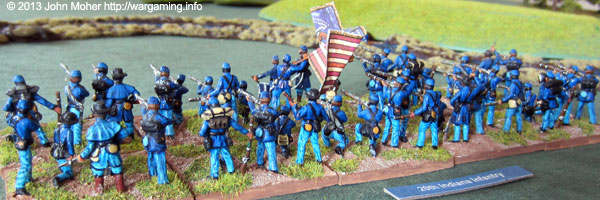
I have previously described to you, my readers, the current state of my command – and it was with this force that I deployed to secure several important fords across the generally impassable lower Antietam Creek. My deployment consisted of covering each of 4 identified fords with a portion of my force, with the artillery centrally placed to cover as much of the battlefield as possible, and some of my infantry forming a second line as my reserve.
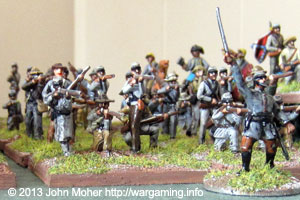
The two New York Regiments’ held my right and the two Michigan ones the centre. My main reserve was the 63rd Pennsylvania and the 20th Indiana had the left supported by the mighty 1st Massachusetts. The enemy forces soon appeared, unknown to us at the time they had advanced knowledge of our situation due to the aforementioned raiders and cavaliers, and we soon spied General A.P.S. Longman’s brigade advancing on our right in some numbers.
The Antietam Creek at this point is really a small river, due to the nature of its banks it is somewhat impassable, and as a consequence the 4 fords or fordable sections of the creek in my forward positions were of critical importance. As a result as soon as the enemy’s positions and apparent intent became known I aggressively advanced to engage him, sending forces across the 2 right flank fords (the 12 NY & 2 MI), and moved the 20th Indiana to utilise the central ford as a possible flanking position against the enemy’s attack.
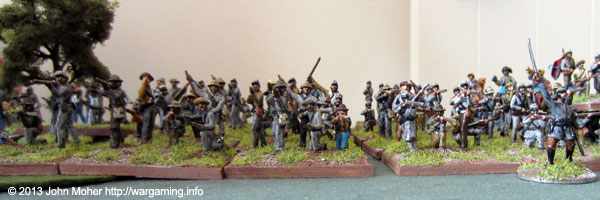
A brisk action with skirmishers soon developed all along the line and I noted General Longman already redeploying an Infantry Regiment (the 7 VA) and his cavalry into his centre in response, which had previously been vacant. By this time my 2 Regiments were ensconced across the right flank fords, and their supporting regiments had moved up in direct support behind them. In the centre the 20th Indiana was crossing the ford and beginning to surmount the small hill that the creek wound its way around. It is of note that the creek ran through, in this area, a rather wooded and scrubby area, providing much cover for the approaching Confederates.
The brisk skirmishing on my right soon developed into a major action and the Rebels were soon upon my forward regiments with their bayonets – regrettably the 12th New York was trapped across the creek and quickly overrun by 17th Virginia Volunteers, while the 2nd Michigan was thrown back over its ford by the combined 11th Virginia & 19th Mississippi Regiments. The time was now right for the 20th Indiana to strike, the 19th Mississippi had dangerously exposed it’s flank and was open to being dealt a good blow – alas some confusion and apparent questioning of the intent of my orders by the Colonel (William L. Brown) resulting in the opportunity being missed and my plan for the centre stalling.
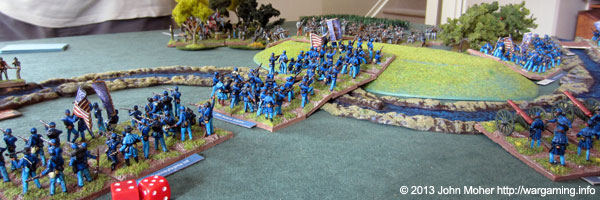
The 20th Indiana were then hit in their flank instead, by the 7th Virginia and chased back across their ford, while the 19th Mississippi followed up its success and following the retiring 2nd Michigan across its ford resumed its assault. On the extremes of both flanks the sounds of on-going skirmishing and occasional heavier volley firing rolled through the air continuously.
Battery M, 2nd U.S. Artillery now joined the fray, blasting the 19th Mississippi at close range directly across the creek, as the battle weary 2nd Michigan got thrown back from the ford by the Mississippians with more casualties. (By this stage the casualty count favoured the Confederates 11 to 4). Some devastating close range volley fire from the 11th and 17th Virginian Regiments then decimated the supporting 3rd Michigan Infantry, and suddenly my division was almost spent. With our will shattered we were forced to abandon the contest and gave the field to Longman’s Brigade!
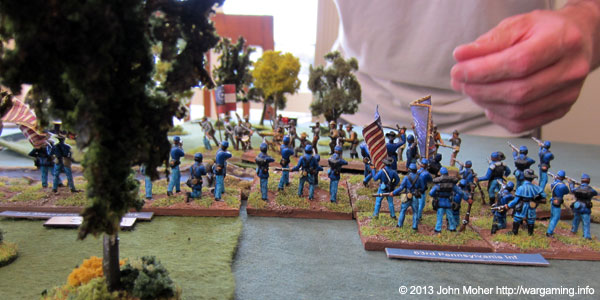
It had been a very bloody affair, and my forces had ended up at the conclusion thus:
- 1st “Mighty” Massachusetts Infantry Regiment (Strength 3; Veteran)
- 2nd Michigan Infantry Regiment (Strength 3; Veteran)
- 3rd Michigan Infantry Regiment – Dispersed, Attempting to Reform
- 12th New York Infantry Regiment – Dispersed, Attempting to Reform
- 69th New York Infantry Regiment (Strength 4; Veteran)
- 20th Indiana Infantry Regiment (Strength 7)
- 63rd Pennsylvania Infantry Regiment (Strength 5)
- Battery M, 2nd US Artillery (2 x Rifles)
- Victory Points Earned: 2
Meanwhile General Longman’s brigade were left in possession of the battlefield in (we believe) the following state:
- 1st Virginia Volunteer Infantry Regiment (Strength 3)
- 7th Virginia Volunteer Infantry Regiment (Strength 4; Veteran)
- 11th Virginia Volunteer Infantry Regiment (Strength 5; Hero)
- 17th Virginia Volunteer Infantry Regiment (Strength 3; Sharpshooters)
- 10th Alabama Volunteer Infantry Regiment (Strength 4; Veteran)
- 19th Mississippi Volunteer Infantry Regiment (Strength 7)
- 2nd Virginia “Lynchburg Cougars” Cavalry (Strength 4)
- Victory Points Earned: 5
The following day the armies fought a major action just North of our position across the same creek, just in front of the town of Sharpsburg, our action proving a precursor to it. The result was inconclusive yet again and General Lee eventually retired back to Virginia. We followed him warily, then shortly after, with October arriving, we headed for our winter quarters…
















I think the Union lost sight of the mission and paid the price 😉
It appears that they were supposed to deny the fords to the rebs, let the heat of the battle go to their heads and rushed off after the rebs, splitting their forces either side of the river/hill and getting a bloody nose
will he lose his job?
lol cheers
Actually he gets a promotion! 😉
hahaha nice, guess they did keep the hopeless around 😉
Lets see what happens next
cheers
Hahaha… Yeah something like that… Lots to come – completed the 5th battle & campaign turn today… Bit of writing up to be done next few days! 🙂
What size are the bases for the infantry figures?
Hi Justin – Cam’s 1/72nd plastics in the photos are on 45mm x 40mm bases for the Infantry & Cavalry. However this was because another gamer at our club had 28mm figures based this way for Black Powder. I have a reasonable 28mm force half-done (I will post some pics in the next week or so) and I am basing mine on 40mm x 30mm bases (3 figs per base for Inf & 2 for Cav). This is to keep the figs compatible to rules like Fire & Fury. Another gamer at our club has this basing as well, and has 4-5 infantry per base (Perry’s Plastics). See this post here on my blog: Fire & Fury: The ACW in 28mm.
The reason the two of us had selected 40mm frontages was to keep the unit ground area smaller – so you don’t need a huge table to play on (e.g. with Fire & Fury you can have 100+ bases on table for each side). With our campaign here our peak forces are about 50-60 bases a side, and with 40mm frontages you’d be able to place most of the battle son the 1200mm x 1200mm table (4′ x 4′) in the photos…
Cam has indicated he may re-base his 1/72 plastics to 40mm x 30mm as well at some stage – for the same reason about table size.
I am looking at basing 10mm Pendraken on 30mm x 30mm bases. With six (or four) figures per base, they will work well with Black Powder, and also limit the frontage of the army. I am not a fan of F&F and others in my club have large collections based for it, so keeping them to a dual LS/BP usage should work out for me.
Thanks for the detailed answer. I envy you playtesters, muchly.
Hi Justin – that sounds a good plan for 10mm figs… Having smaller Base Frontages also allows games to be played on smaller tables since your Base Width becomes the primary increment for everything…
P.S. With my 28mm figs I am putting them in one (disorderly) rank per base – so if my unit is 2 bases deep it visually looks like 2 ranks, 3 dee = 3 ranks, etc… I’l post some in progress photos soon so you can see what I mean.
Ah, yes, I will look out for those. I hope to get my first unit of Union figures in the mail soon, then to paint!
Hi Justin – JFWIW I have some initial pics of my first batch of 28mm figures up now…
I’ve started following this campaign. I must say this looks promising.
Thanks Sebastien – as mentioned I hope to get the results of 2 more battles & all 3 campaign turns up over the next few days… We are currently up to mid-1863 now… 🙂